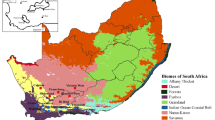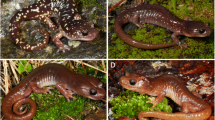Abstract
Genetic variation is now routinely screened at the DNA sequence level in many studies. If the DNA region being screened has not experienced excessive amounts of recombination, it is often possible to reconstruct the evolutionary history of the genetic variation in the form of a haplotype tree. This tree estimates the evolutionary pathway that interconnects all the different haplotypes (sequence variants) observed in the sample. This haplotype tree can be used to define a series of nested branches (clades) that reflects the relative temporal history of the haplotypes and groups of haplotypes. Geographical information can then be overlaid upon this temporal series to test for significant associations between geography and temporal position in the haplotype tree. This allows a reconstruction of how the genetic variation arose and spread in both space and time. Such reconstructions can yield many insights into the joint roles of recurrent events such as gene flow and of historical events such as fragmentation or range expansion. These points are illustrated with studies on the chub, Leuciscus cephalus. There is also a need to extend such nested phylogeographic analyses to a phylo/reticulate geographic analysis that incorporates both assortment and recombination between and within DNA regions. A preliminary phylo/reticulate geographic analysis is presented of the transferrin locus in the brown trout, Salmo trutta, species complex that reveals the importance of hybridization in the recent evolutionary history of this group. This example shows the inadequacy of a strictly phylogenetic approach and illustrates the need to incorporate reticulate evolution. The results of nested clade phylogeographic analysis and the new phylo/reticulate geographic analysis are then used for inferring species status of the marbled trout. The results indicate that an old hybridization event may have played a role in the origin of the marbled trout. Currently the marbled trout is primarily endangered by hybridization with introduced brown trout. These results show both the positive and negative impacts of hybridization upon biodiversity. Such phylo/reticulate geographic studies will challenge both our concepts of species and our conservation management strategies.
Similar content being viewed by others
References
Antunes, A., A.R. Templeton, R. Guyomard & P. Alexandrino. 2002. The role of nuclear genes in intraspecific evolutionary inference: Genealogy of the transferrin gene in the brown trout. Mol. Biol. Evol. 19: 1272–1287.
Behnke, R.J. 1972. The systematics of salmonid fishes of recently glaciated lakes. J. Fish. Res. Board Can. 29: 639–671.
Bernatchez, L. 2001. The evolutionary history of brown trout (Salmo trutta L.) inferred from phylogeographic, nested clade, and mismatch analyses of mitochondrial DNA variation. Evolution 55: 351–379.
Bernatchez, L., R. Guyomard & R. Bonhomme. 1992. DNA sequence variation of the mitochondrial control region among geographically and morphologically remote European brown trout Salmo trutta populations. Mol. Ecol. 1: 161–173.
Bouza, C., J. Arias, J. Castro, L. Sánchez & P. Martínez. 1999. Genetic structure of browntrout, Salmo trutta L., at the southern limit of the distribution range of the anadromous form. Mol. Ecol. 8: 1991–2002.
Castelloe, J. & A.R. Templeton. 1994. Root probabilities for intraspecific gene trees under neutral coalescent theory. Mol. Phylogen. Evol. 3: 102–113.
Clark, A.G. 1990. Inference of haplotypes from PCR-amplified samples of diploid populations. Mol. Biol. Evol. 7: 111–122.
Crandall, K.A. & A.R. Templeton. 1999. Statistical approaches to detecting recombination. pp. 153–176. In: K.A. Crandall (ed.) The Evolution of HIV, The Johns Hopkins University Press, Baltimore.
Durand, J.D., A.R. Templeton, B. Guinand, A. Imsiridou & Y. Bouvet. 1999. Nested clade and phylogeographic analyses of the chub, Leuciscus cephalus (Teleostei, Cyprinidae) in Greece: Implications for Balkan Peninsula biogeography. Mol. Phylogen. Evol. 13: 566–580.
García-Marín, J.L., F.M. Utter & C. Pla. 1996. Origins and relationships of native populations of Salmo trutta (brown trout) in Spain. Heredity 77: 313–323.
Hull, D.L. 1997. The ideal species concept-and why we can't get it. pp. 357–380. In: M.F. Claridge, H.A. Dawah & M.R. Wilson (ed.) Species: The Units of Biodiversity, Chapman & Hall, London.
O'Brien, S.J. & E. Mayr. 1991. Bureaucratic mischief: Recognizing endangered species and subspecies. Science 251: 1187–1188.
Povz, M. 1995. Status of freshwater fishes in the Adriatic catchment of Slovenia. Biol. Conserv. 72: 171–177.
Rieseberg, L.H. 1997. Hybrid origins of plant species. Ann. Rev. Ecol. Syst. 28: 359–389.
Sommani, E. 1960. II Salmo marmoratus Cuv. sua origine e distribuzione nell'Italia settentrionale. Bolletino di Pesca, Piscicoltura e Idrobiologia 15: 40–47.
Swofford, D. 2002. PAUP*: Phylogenetic Analysis Using Parsimony (and other methods). Version 4. Sinauer, Sunderland, MA.
Templeton, A.R. 1989. The meaning of species and speciation: A genetic perspective. pp. 3–27. In: D. Otte & J.A. Endler (ed.) Speciation and its Consequences, Sinauer, Sunderland, Massachusetts.
Templeton, A.R. 1998a. Nested clade analyses of phylogeographic data: Testing hypotheses about gene flow and population history. Mol. Ecol. 7: 381–397.
Templeton, A.R. 1998b. Species and speciation: Geography, population structure, ecology, and gene trees. pp. 32–43. In: D.J. Howard & S.H. Berlocher (ed.) Endless Forms: Species and Speciation, Oxford University Press, Oxford.
Templeton, A.R. 1999. Using gene trees to infer species from testable null hypothesis: Cohesion species in the Spalax ehrenbergi complex. pp. 171–192. In: S.P. Wasser (ed.) Evolutionary Theory and Processes: Modern Perspectives, Papers in Honour of Eviatar Nevo, Kluwer Academic Publishers, Dordrecht.
Templeton, A.R. 2001. Using phylogeographic analyses of gene trees to test species status and processes. Mol. Ecol. 10: 779–791.
Templeton, A.R. 2002. Out of Africa again and again. Nature 416: 45–51.
Templeton, A.R. & C.F. Sing. 1993. A cladistic analysis of phenotypic associations with haplotypes inferred from restriction endonuclease mapping. IV. Nested analyses with cladogram uncertainty and recombination. Genetics 134: 659–669.
Templeton, A.R., E. Boerwinkle & C.F. Sing. 1987. A cladistic analysis of phenotypic associations with haplotypes inferred from restriction endonuclease mapping. I. Basic theory and an analysis of Alcohol Dehydrogenase activity in Drosophila. Genetics 117: 343–351.
Templeton, A.R., K.A. Crandall & C.F. Sing. 1992. A cladistic analysis of phenotypic associations with haplotypes inferred from restriction endonuclease mapping & DNA sequence data. III. Cladogram estimation. Genetics 132: 619–633.
Templeton, A.R., E. Routman & C. Phillips. 1995. Separating population structure from population history: A cladistic analysis of the geographical distribution of mitochondrial DNA haplotypes in the Tiger Salamander, Ambystoma tigrinum. Genetics 140: 767–782.
Templeton, A.R., A.G. Clark, K.M. Weiss, D.A. Nickerson, J. Stengård, E. Boerwinkle & C.F. Sing. 2000a. Recombinational and mutational hotspots within the human Lipoprotein Lipase gene. Amer. J. Hum. Gen. 66: 69–83.
Templeton, A.R., S.D. Maskas & M.B. Cruzan. 2000b. Gene trees: A powerful tool for exploring the evolutionary biology of species and speciation. Plant Species Biol. 15: 211–222.
Templeton, A.R., K.M. Weiss, D.A. Nickerson, E. Boerwinkle & C.F. Sing. 2000c. Cladistic structure within the human Lipoprotein lipase gene and its implications for phenotypic association studies. Genetics 156: 1259–1275.
Wright, S. 1943. Isolation by distance. Genetics 28: 114–138.
Author information
Authors and Affiliations
Rights and permissions
About this article
Cite this article
Templeton, A.R. Using Haplotype Trees for Phylogeographic and Species Inference in Fish Populations. Environmental Biology of Fishes 69, 7–20 (2004). https://doi.org/10.1023/B:EBFI.0000022870.76912.0c
Issue Date:
DOI: https://doi.org/10.1023/B:EBFI.0000022870.76912.0c




